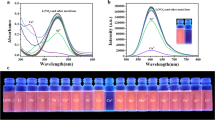Abstract
A highly sensitive fluorogenic probe for captopril, 4-methylumbelliferyl-2, 4-dinitrobenzenesulfonate (4-MUDNBS), was designed and synthesized. 4-MUDNBS is a nonfluorescent compound and was synthesized via the one-step reaction of 4-methylumbelliferone (4-MU) with 2,4-dinitrobenzenesulfonyl chloride. Upon mixing with captopril in basic solution, the 2,4-dinitrobenzenesulfonyl group of 4-MUDNBS was efficiently removed and highly fluorescent 4-MU was released, hence leading to the dramatic fluorescence increase of the reaction solution. The fluorescence intensity is linear with captopril concentration in the range 3.0–500 ng mL−1 with a detection limit of 2.2 ng mL−1 (3σ). The effect of substituents on the benzenesulfonyl moiety of the probe is discussed, and the presence of electronegative groups is favorable for the thiolate-induced cleavage reaction. The proposed method has been successfully applied to the captopril determination in pharmaceutical preparations.









Similar content being viewed by others
References
Fiorey K (1982) Analytical profiles of drug substances (Ed.), Vol. 11, Academic Press, New York, 1982, pp. 81–136
Huang TM, He Z, Yang B, Shao LP, Zheng XW, Duan GL (2006) Simultaneous determination of captopril and hydrochlorothiazide in human plasma by reverse-phase HPLC from linear gradient elution. J Pharm Biomed Anal 41(2):644–648. doi:10.1016/j.jpba.2005.12.007
Rezende KR, Mundim IM, Teixeira LS, Souza WC, Ramos DR, Cardoso CRF, Souza IC, Gratao MZ, Bellorio KB (2007) Determination of captopril in human plasma, using solid phase extraction and high-performance liquid chromatography, coupled to mass spectrometry: Application to bioequivalence study. J Chromatogr B Analyt Technol Biomed Life Sci 850(1–2):59–67. doi:10.1016/j.jchromb.2006.11.007
Kusmierek K, Bald E (2007) A simple liquid chromatography method for the determination of captopril in urine. Chromatographia 66(1–2):71–74. doi:10.1365/s10337-007-0232-8
Karlicek R, Solich P (1998) Flow-injection spectrophotometric determination of captopril using on-line solid phase extraction. Pharmazie 53(8):549–551
Tzanavaras PD, Themelis DG, Economou A, Theodoridis G (2002) Reversed flow-injection manifold for the spectrophotometric determination of captopril based on its inhibitory effect on the Co(II)-2,2′-dipyridyl-2-pyridylhydrazone complex formation. Talanta 57(3):575–581. doi:10.1016/S0039-9140(02)00059-0
Tzanavaras PD, Themelis DG, Economou A, Theodoridis G (2003) Flow and sequential injection manifolds for the spectrophotometric determination of captopril based on its oxidation by Fe(III). Mikrochim Acta 142(1–2):55–62. doi:10.1007/s00604-003-0952-x
Palomeque ME, Band BSF (2002) Flow injection biamperometric determination of captopril. J Pharm Biomed Anal 30(3):547–552. doi:10.1016/S0731-7085(02)00315-1
Siangproh W, Ngamukot P, Chailapakul O (2003) Electrochemical determination of captopril at boron-doped diamond thin film electrode applied to a flow injection system. Sens Actuators B Chem 91(1–3):60–66. doi:10.1016/S0925-4005(03)00067-4
Ioannides X, Economou A, Voulgaropoulos A (2003) A study of the determination of the hypertensive drug captopril by square wave cathodic adsorptive stripping voltammetry. J Pharm Biomed Anal 33(2):309–316. doi:10.1016/S0731-7085(03)00262-0
Parham H, Zargar B (2005) Square-wave voltammetric (SWV) determination of Captopril in reconstituted serum and pharmaceutical formulations. Talanta 65(3):776–780. doi:10.1016/j.talanta.2004.08.005
Shahrokhian S, Karimi M, Khajehsharifi H (2005) Carbon-paste electrode modified with cobalt-5-nitrolsalophen as a sensitive voltammetric sensor for detection of captopril. Sens Actuators B Chem 109(2):278–284. doi:10.1016/j.snb.2004.12.059
Li BX, Zhang ZJ, Wu ML (2001) Flow-injection chemiluminescence determination of captopril using on-line electrogenerated silver (II) as the oxidant. Microchem J 70:85–91. doi:10.1016/S0026-265X(01)00090-X
Pulgarin JAM, Bermejo LFG, Lopez PF (2005) Sensitive determination of captopril by time-resolved chemiluminescence using the stopped-flow analysis based on potassium permanganate oxidation. Anal Chim Acta 546(1):60–67. doi:10.1016/j.aca.2005.05.014
Zheng XW, Zhang ZJ, Li BX (2001) Flow injection chemiluminescence determination of captopril with in situ electrogenerated Mn3+ as the oxidant. Electroanalysis 13(12):1046–1050. doi:10.1002/1521-4109(200108)13:12<1046::AID-ELAN1046>3.0.CO;2-5
Du JX, Li YH, Lu JR (2002) Flow injection chemiluminescence determination of captopril based on its enhancing effect on the luminol-ferricyanide/ferrocyanide reaction. Luminescence 17(3):165–167. doi:10.1002/bio.685
Economou A, Themelis DG, Theodoridis G, Tzanavaras PD (2002) Sensitive determination of captopril by flow injection analysis with chemiluminescence detection based on the enhancement of the luminol reaction. Anal Chim Acta 463(2):249–255. doi:10.1016/S0003-2670(02)00424-5
Hillaert S, Van den Bossche W (1999) Determination of captopril and its degradation products by capillary electrophoresis. J Pharm Biomed Anal 21(1):65–73. doi:10.1016/S0731-7085(99)00092-8
Perez-Ruiz T, Martinez-Lozano C, Galera R (2006) Development and validation of a capillary electrophoresis method with laser-induced fluorescence detection for the determination of captopril in human urine and pharmaceutical preparations. Electrophoresis 27(12):2310–2316. doi:10.1002/elps.200500861
Al-Ghannam SM, El-Brashy AM, Al-Farhan BS (2002) Fluorimetric determination of some thiol compounds in their dosage forms. Farmaco 57(8):625–629
Ivashkiv E (1984) Spectrofluorometric determination of captopril plus captopril disulfide metabolites in plasma. J Pharm Sci 73:1427–1430. doi:10.1002/jps.2600731026
Tache F, Farca A, Medvedovici A, David V (2002) Validation of a LC-fluorescence method for determination of free captopril in human plasma, using a pre-column derivatization reaction with monobromobimane. J Pharm Biomed Anal 28(3–4):549–557. doi:10.1016/S0731-7085(01)00687-2
Kok RJ, Visser J, Moolenaar F, de Zeeuw D, Meijer DKF (1997) Bioanalysis of captopril: two sensitive high-performance liquid chromatographic methods with pre- or postcolumn fluorescent labeling. J Chromatogr B Analyt Technol Biomed Life Sci 693(1):181–189. doi:10.1016/S0378-4347(97)00002-9
Imai K, Toyo'oka T, Watanabe Y (1983) A novel fluorogenic reagent for thiols: ammonium 7-fluorobenzo-2-oxa-1,3-diazole-4-sulfonate. Anal Biochem 128(2):471–473. doi:10.1016/0003-2697(83)90404-9
Searles S, Nukima S (1959) Cleavage and rearrangement of sulfonamides. Chem Rev 59:1077–1103. doi:10.1021/cr50030a004
Fukuyama T, Cheung M, Jow C-K, Hidai Y, Kant T (1997) 2,4-Dinitrobenzenesulfonamides: a simple and practical method for the preparation of a variety of secondary amines and diamines. Tetrahedron Lett 38(33):5831–5834. doi:10.1016/S0040-4039(97)01334-8
Nihei K-i, Kato MJ, Yamane T, Palma MS, Konno K (2001) 2-Nitro- and 2,4-dinitrobenzenesulfonamides as protecting groups for primary amines. Synlett 7:1167–1169. doi:10.1055/s-2001-15158
Gee KR, Sun W-C, Bhalgat MK, Upson RH, Klaubert DH, Latham KA, Haugland RP (1999) Fluorogenic substrates based on fluorinated umbelliferones for continuous assays of phosphatases and β-galactosidases. Anal Biochem 273:41–48. doi:10.1006/abio.1999.4202
Adamczyk M, Cornwell M, Huff J, Rege S, Rao TVS (1997) Novel 7-hydroxycoumarin based fluorescent labels. Bioorg Med Chem Lett 7(15):1985–1988. doi:10.1016/S0960-894X(97)00345-4
Acknowledgements
This work was supported by The Education Department of Shaanxi Province of China (No. 07JK406) and The Natural Science Foundation of Shaanxi Province of China.
Author information
Authors and Affiliations
Corresponding author
Rights and permissions
About this article
Cite this article
Wang, L., Yang, XF. & Zhao, M. A 4-Methylumbelliferone-based Fluorescent Probe for the Sensitive Detection of Captopril. J Fluoresc 19, 593–599 (2009). https://doi.org/10.1007/s10895-008-0449-4
Received:
Accepted:
Published:
Issue Date:
DOI: https://doi.org/10.1007/s10895-008-0449-4




